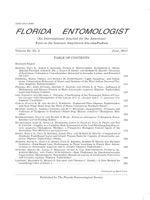Brachiacantha Dejean 1837 (Coleoptera: Coccinellidae: Hyperaspini) is a New World genus with approximately 50 species and subspecies distributed from Canada to Argentina (Leng 1911; Gordon 1985). Brachiacantha quadripunctata (Melsheimer) is distributed over the eastern United States with 2 allopatric subspecies that have distinct elytral color patterns (Leng 1911; Gordon 1985). The elytron of B. quadripunctata quadripunctata (Melsheimer) has a basal spot and an apical spot in females, and an additional humeral spot that is often confluent with the basal spot in males (Fig. 1). The elytron of B. quadripunctata flavifrons Mulsant has 1 marginal spot in addition to the basal and apical spots (Fig. 2). Brachiacantha quadripunctata quadripunctata has a northern distribution from Kansas to Massachusetts, and south into Arkansas and Tennessee, whereas B. quadripunctata flavifrons is distributed in the southeastern U.S. from North Carolina to northern Florida and westward to southern Alabama (Gordon 1985). Neither subspecies has been recorded from Mississippi (Gordon 1985). Leng (1911) stated that the distribution of B. quadripunctata includes Mississippi and Louisiana, but he provided no records of this species for those states. However, in reviewing curated beetles, we discovered specimens of both B. quadripunctata quadripunctata and B. quadripunctata flavifrons from Mississippi, and here report their first records from the state.
New records of adult beetles were obtained from specimens in insect collections at the University of Mississippi (UMIC) and Mississippi Entomological Museum (MEM), Mississippi State University. We failed to find any B. quadripunctata quadripunctata or B. quadripunctata flavifrons from Mississippi in the collection database at Louisiana State University ( http://collection.silverbiology.com/lsam/collection/). In all, the following 15 specimens were recorded.
Brachiacantha quadripunctata quadripunctata. MEM: Choctaw County, 9 mi. NE Ackerman, 25-VI-1971, J. E. Leggett; Oktibbeha County, 4.3 SW Starkville, 9-III-1976, W. H. Cross; Winston County, near Noxapater, 1-III-1977, W. H. Cross; Oktibbeha County, Craig Springs, 5-III-1982, W. H. Cross; Oktibbeha County, Adaton, 15-III-1982, W. H. Cross; Noxubee County, Noxubee Wild. Ref., 8-III-1986, A. Tonhasca; Choctaw County, Jeff Busby Park, 4-IX-1992, R. L. Brown [2 adults]; Oktibbeha County, Starkville, Dorman Lake, 25-IV-1994, D. M. Pollock; Oktibbeha County, Starkville, Dorman Lake, 12-V-1995, D. M. Pollock; Winston County, Tombigbee National Forest, 33°0′20″N, 89°03′55″W, 10-V-1999, T. L. Schiefer; Choctaw County, Natchez Trace, mi. 199.4, 34°29′04″N, 89°11′52″W, 18-III-2004, T. L. Schiefer; Itawamba County, Natchez Trace, mi. 280.8, 34°26′41″N, 88°30′46″W, 13-III-2008, T. L. Schiefer.
UMIC: Grenada County, 6 mi. S. Grenada, 20-III-1992, M. S. Caterino.
Brachiacantha quadripunctata flavifrons. MEM: Choctaw County, 9 mi. NE Ackerman, 17-VI-1971, J. E. Leggett; Choctaw County, 9 mi. NE Ackerman, 25-VI-1971, J. E. Leggett.
Our discovery of specimens of B. quadripunctata quadripunctata and B. quadripunctata flavifrons from Mississippi establishes state records of these subspecies, and these records extend their known geographic distributions about 150 km, respectively, southward and westward. Moreover, their co-occurrence in Choctaw County in Jun 1971 shows that these subspecies are sympatric and synchronic in this part of their range, and contrast with previous collections records that have shown that B. quadripunctata quadripunctata and B. quadripunctata flavifrons are allopatric (Gordon 1985).
The presence of both subspecies of B. quadripunctata suggests that each elytral color phenotype is generally favored in Mississippi. However, additional studies are needed to determine whether distinct phenotypes are maintained possibly under genetic introgression between the 2 subspecies, or if phenotypes are maintained because introgression is limited or perhaps absent. Other studies are needed to survey for the 2 sub-species in other areas in which their ranges could potentially overlap (i.e., northern Alabama, northern Georgia, and eastern Tennessee).
Little is known about the bionomics of Brachiacantha species and factors that determine their abundance (Gordon 1985; Majka & Robinson 2009). For instance, there is only very limited information regarding the larvae of Brachiacantha, but in the few known instances they have been associated with root-feeding coccids and aphids found in ant nests (Leng 1911; Gordon 1985). Wheeler (1911) found larvae of B. quadripunctata quadripunctata in nests of the ant, Lasius flavus (F.) (as Lasius umbratus var. aphidicola), provisioned with root coccids and root aphids, but we are unaware of any reports for B. quadripunctata flavifrons. Similarly, published accounts on the ecology of adult Brachiacantha are generally lacking (Acorn 2007; Majka & Robinson 2009). Thus, additional studies are needed to understand factors that may allow the subspecies of B. quadripunctata to overlap in distribution in Mississippi but drive allopatry between them in other areas.
Faunal lists may increase from additional collecting, curation and examination of previously collected material, and geographic range expansion of species (Fauske et al. 2003; McCorquodale & Bondrup-Nielsen 2004). In the present study, discovery of specimens of B. quadripunctata quadripunctata and B. quadripunctata flavifrons dating to 1971 came from the examination of previously collected material. This discovery reinforces the argument that ongoing curation and periodic review of collections is important in maintaining accurate regional lists of species for comparisons across geographic regions, and for developing hypotheses about changes in faunal distributions over time (Brodman et al. 2002; McCorquodale & Bondrup-Nielsen 2004; Hesler & Kieckhefer 2008).
SUMMARY
The first records of the lady beetles Brachiacantha quadripunctata quadripunctata (Melsheimer) and B. quadripunctata flavifrons Mulsant from Mississippi and their occurrence in sympatry are reported following a review of previously collected material. The new records also extend the known geographic distribution of B. quadripunctata quadripunctata and B. quadripunctata flavifrons about 150 km, respectively, southward and westward. Our findings support the argument that ongoing curation and periodic review of collections is critical for maintaining accurate regional faunal lists, in developing hypotheses about the geographic distributions of species, and to track changes in both through time.
ACKNOWLEDGMENTS
Matthew Brust, Kent Fothergill, and Lauren Hesler reviewed drafts of this paper. Terry Schiefer loaned specimens from the Mississippi Entomological Museum, Mississippi State University. Terry Molengraaf photographed specimens of B. quadripunctata quadripunctata and B. quadripunctata flavifrons. This work was supported in part by a grant from the National Science Foundation to L.S.H.







